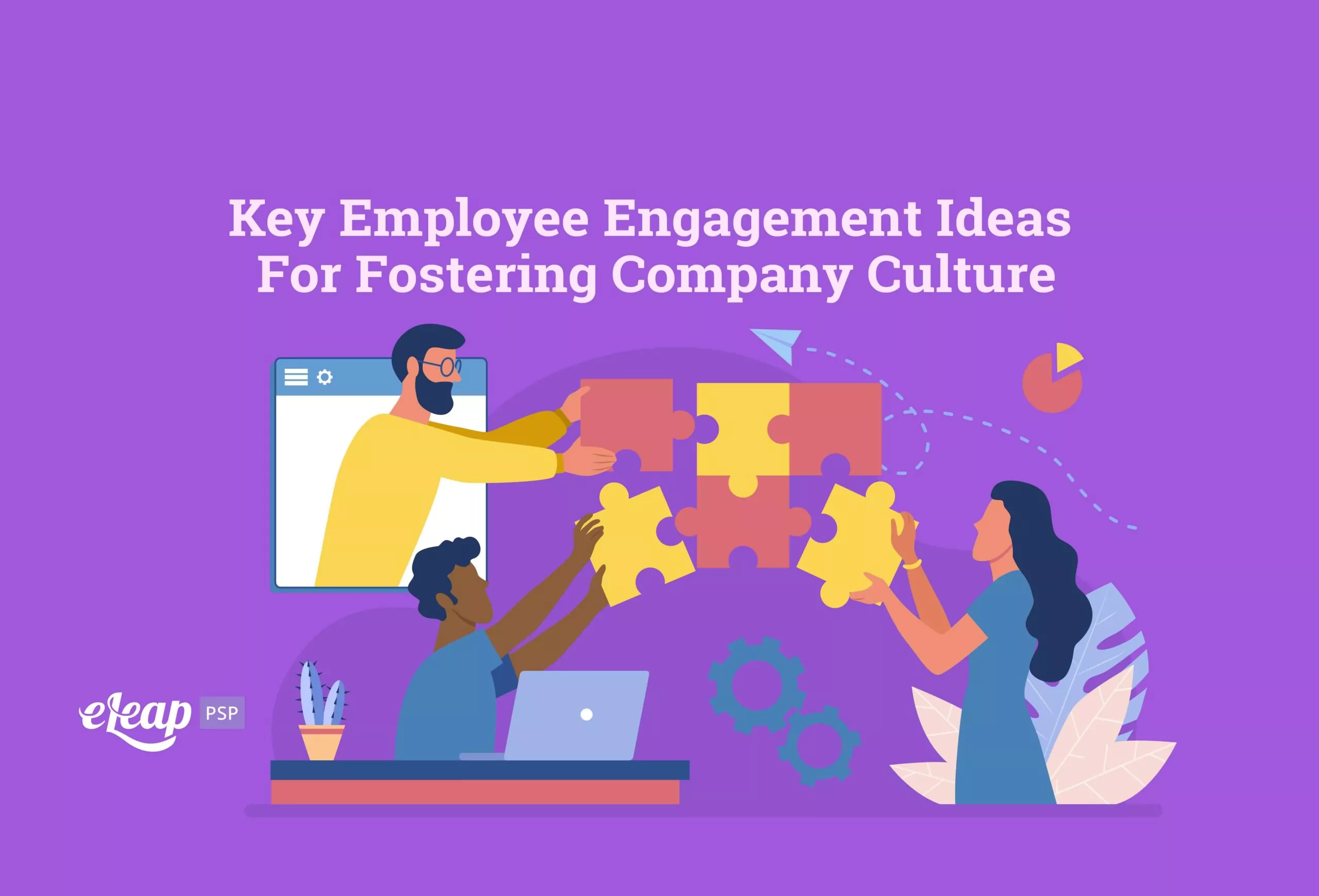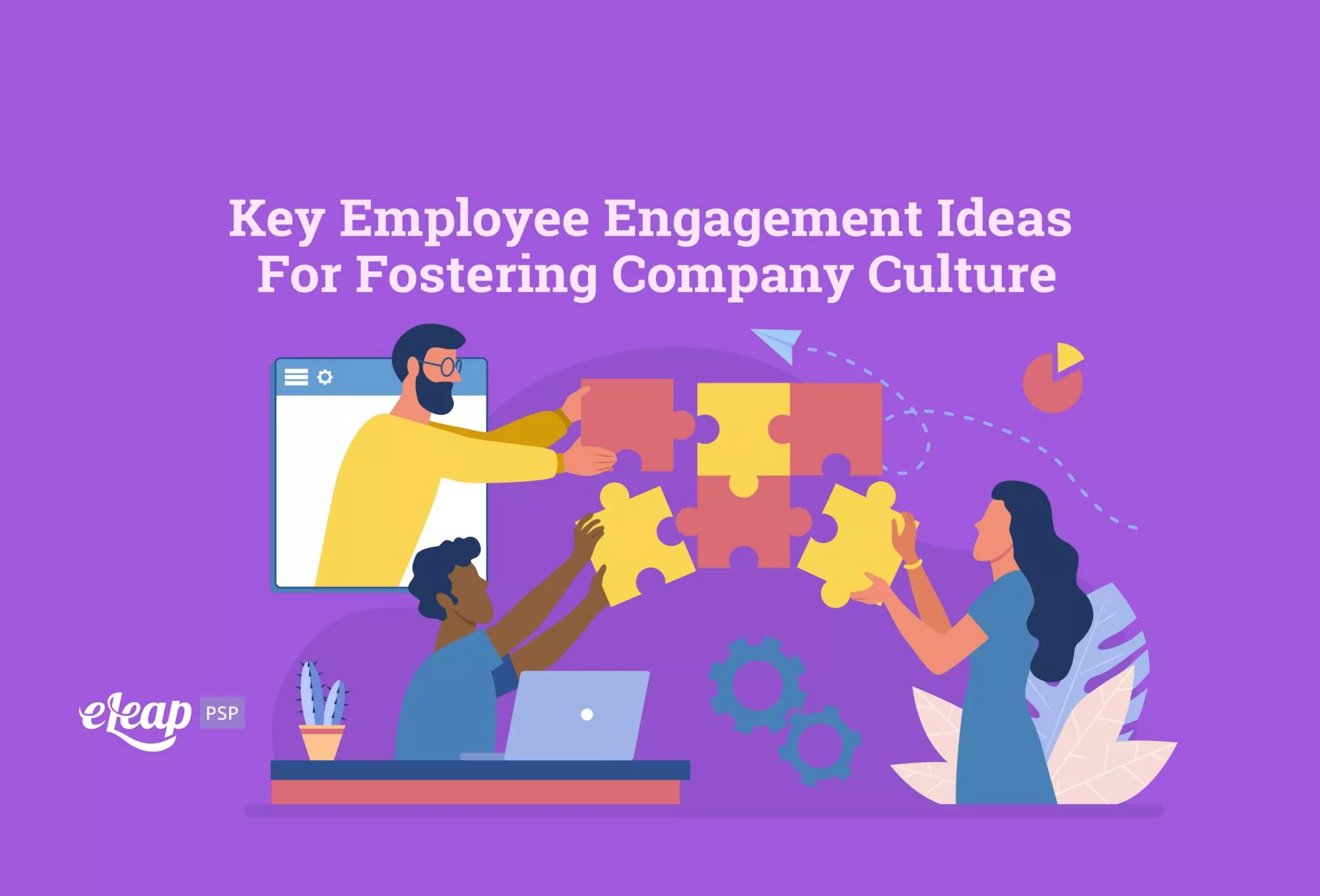Key Employee Engagement Ideas For Fostering Company Culture

Employee engagement ideas are one of the most popular buzzwords in human resources and are frequently used to assess productivity and job satisfaction levels. People today want more than to go to work, do their jobs, and go home; they want to feel a sense of belonging and value from their employer. Explore how eLeaP®’s Performance Management Platform can simplify evaluations, boost productivity, and drive measurable results.
Sadly, the vast majority of workers have become too jaded and cynical. According to Gallup, only 36% of employees are engaged at work. Managers must look for strategies to keep their staff members happy and involved. Look at important employee engagement ideas to improve your organization’s culture and garner better engagement outcomes.

Understanding Employee Engagement
An engaged workforce is enthusiastic about their work and is deeply involved in advancing the organization’s goals and objectives. They are dedicated to their work and have a positive outlook on the organization and its principles. A disengaged employee, in contrast, will perform the bare minimum amount of tasks to get by or even aggressively criticize the organization to anyone who would listen.
You can develop strategies to increase employee engagement using tools that track your organization’s culture and measure organizational climate and work satisfaction. You can also evaluate survey data to get insights into your team’s engagement and morale.
Why is it Crucial for Employees to be Engaged?
Employee engagement involves more than simply being content with one’s job; it’s about having a sense of pride in one’s work and an attachment to the organization. High engagement frequently leads to higher work quality, efficiency, and an increasing pride in one’s output.
Employees who are engaged are dedicated to improving both their jobs and the organization as a whole. They are less inclined to leave their job for a better title or a higher income at another organization. This, in turn, lowers your turnover rate. When staff members are engaged, customer satisfaction, employee retention, and a firm’s overall financial well-being.
Top Employee Engagement Ideas for Your Workforce
It’s crucial to employ valuable strategies to improve employee engagement. It takes time to strengthen your employees’ loyalty to the organization, and the shift must be natural rather than forced. Here are some ideas for enhancing employee engagement in your organization.
Schedule Leisure Time
Humans are not meant to be labor-intensive machines. Provide enjoyable team-building activities that let your staff unwind and have fun. Here are a few concepts:
- Visit a local brewery or sporting event as a business outing.
- On Fridays, order snacks for the entire company.
- Play paintball or go bowling with the team.
- Check out an escape room.
- Organize a treasure hunt.
- Invite a guest to a lunchtime lecture.
Provide Distinctive Employee Discounts
Workplace benefits are a good way to let your employees know you respect and value their contributions to the organization. You might also try giving unique employee discounts such as discounted athletics concert tickets or travel offers.
Communicate Frequently
Interacting with employees is the best way to keep them motivated and focused. Efficient communication, including formal, nonverbal, visual, and written communication, is critical to the growth of any organization. It enhances connections, employee engagement, and a group’s overall effectiveness.
Communication guarantees that teammates are aware of their goals and motivations. Send personalized periodic engagement surveys to employees to get feedback on enhancing communication.
Reduce Micromanagement
Micromanaging tends to reduce employee power while giving a manager more authority. Although micromanagement is sometimes necessary to ensure that employees perform tasks appropriately and are adequately supervised, try allowing employees to complete tasks on their own time.
When employees feel empowered by your trust, you may be surprised by the results and increased engagement. Some have reported that projects can be completed on time and surprisingly to a high standard if they don’t micromanage their employees. Employees tend to be happier when they are trusted to complete tasks independently.
Get to Know Your Staff
Knowing your staff as individuals will help you value and assist them more effectively. A good way to engage employees is to “understand” them. You should aim to help your managers do the same. Create a safe space for employees to share if they feel comfortable doing that. Never force anyone to unburden themselves. Keeping employees engaged is easy when they notice that you care about them.
Provide Chances for Cooperation
Since their workplace is a dominant contributor to their interpersonal interactions, employees with strong relationships with their colleagues are inherently more involved with their workplace. Give your staff opportunities to collaborate and learn more about one another.
Describe How Your Employees Contribute to the Organization
Employees should understand their roles and how their efforts advance the organization’s overall objectives. Without this understanding, you risk making your employees feel they are merely cogs in the ‘machine’, performing work that no one values. To illustrate how each employee’s work affects others and the organization as a whole, you could make a data flow diagram or other visual representation.
Make Work-life Balance a Priority
One of the most essential strategies for increasing employee engagement is demonstrating that you value them as individuals. This includes fostering and exhibiting a healthy work-life balance, including reasonable paid time off, flexible hours, and easy mobility to work. Please do your best to encourage your employees to have a healthy work-life balance even as they try to navigate their careers.
Allow for Change in Roles
Think about enabling simple lateral mobility throughout your organization. This could be very useful for younger staff who still need to choose their ideal career trajectory. If you give employees some flexibility and support them in career mapping, you might be able to keep them from leaving for organizations.
Be Honest and Open
When employees are aware of positive and negative developments, becoming involved with an organization is much easier. As a leader, you should always be open and honest with your team. This demonstrates that you care and trust them enough to share information that impacts them. Of course, there should be a healthy balance in sharing sensitive information that can backfire.
Conclusion
Improved staff engagement has a plethora of advantages. It has been repeatedly demonstrated that contented employees are productive, which benefits your organization. Employee engagement provides lower absenteeism, higher-quality work, and increased revenue. Fortunately, eLeaP can help ensure high employee engagement in your organization. With our Performance Management Plan and many resources and courses in our catalog, you can start or enhance your employee engagement efforts today.